News articles about starting the Scouting Movement
in Ellsworth
|
1917
Ellsworth starts a Troop of Boy Scouts
(these articles published February, May and March
of 1917)
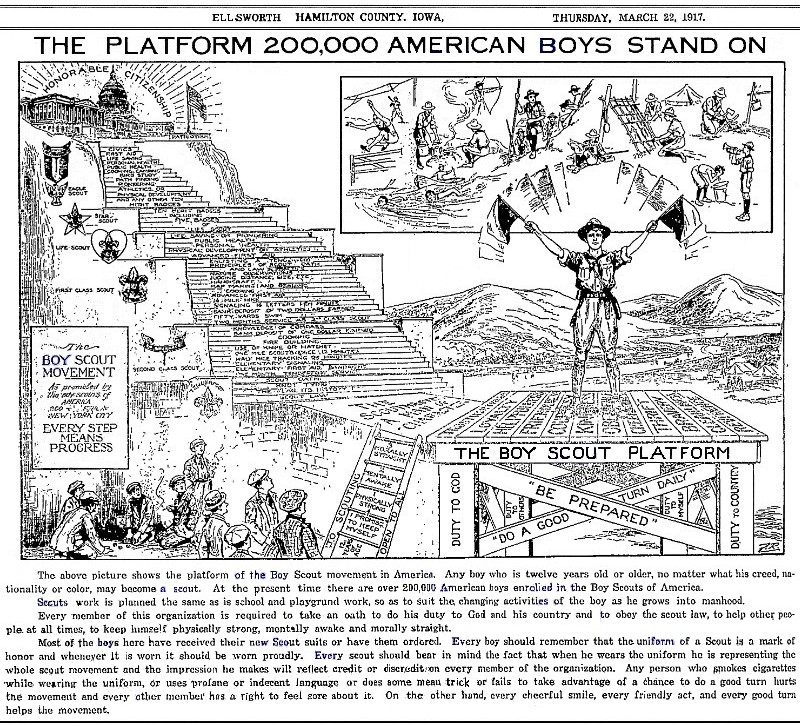
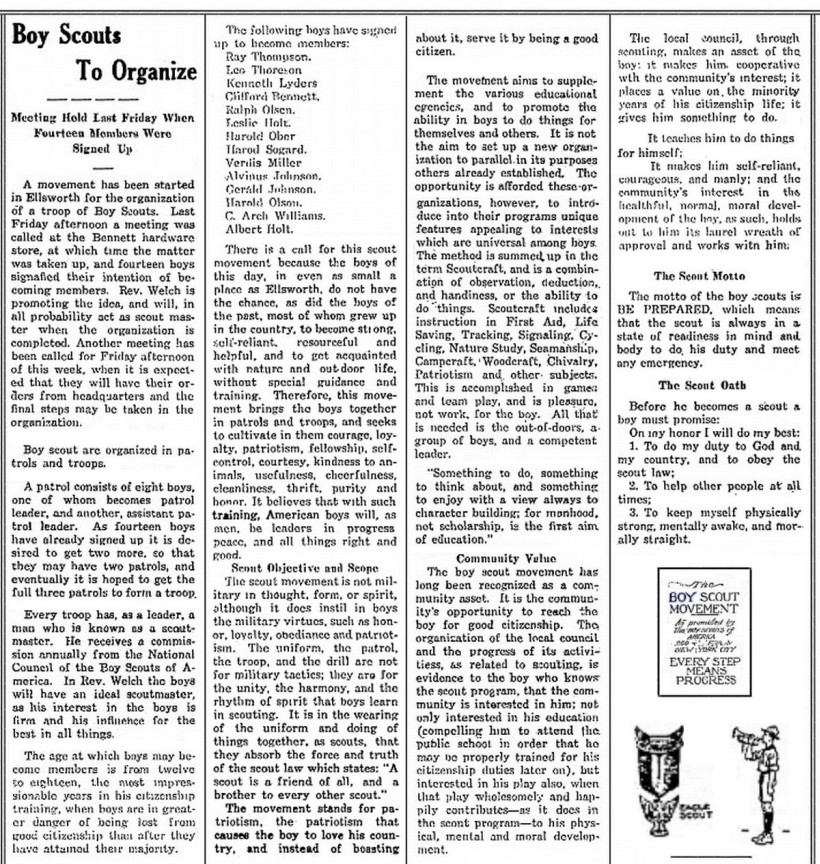
(Article published February 1, 1917 in the Ellsworth News)
Boy Scouts to Organize
Meeting Held Last Friday When Fourteen Members Were
Signed Up
A movement has been
started in Ellsworth for the organization of a troop of Boy Scouts.
Last Friday afternoon a meeting was called at the Bennett hardware store,
at which time the matter was taken up, and fourteen boys signified their
intention of becoming members. Rev. Welch is promoting the
idea, and will, in all probability act as scout master when the organization
is completed. Another meeting has been called for Friday afternoon
of this week, when it is expected that they will have their orders from
headquarters and the final steps may be taken in the organization.
Boy scouts are organized in patrols and troops.
A patrol consists
of eight boys, one of whom becomes patrol leadr, and another, assistant
patrol leader. As fourteen boys have already signed up it is
desired to get two more, so that they may have two patrols, and eventually
it is hoped to get the full three patrols to form a troop.
Every troop has,
as a leader, a man who is known as a scoutmaster. He receives
a commission annually from the National Council of the Boy Scouts of America.
In Rev. Welch, the boys will have an ideal scoutmaster, as his interest
in the boys is firm, and his influence for the best in all things.
The age at which
boys may become members is from twelve to eighteen, the most impressionable
years in his citizenship training, when the boys are in greater danger
of being lost from good citizenship than after they have attained their
majority.
The following boys have signed
up to become members:
Ray Thompson
Leo Thoreson
Kenneth Lyders
Clifford Bennett
Ralph Olson
Leslie Holt
Harold Ober |
Harod Sogard
Verdis Miller
Alvinus Johnson
Gerald Johnson
Harold Olson
C. Arch Williams
Albert Holt |
There is a call
for this scout movement, because the boys of this day, in even as small
a place as Ellsworth, do not have the chance, as did the boys of the past,
most of whom grew up in the country, to become strong, self-reliant, resourceful
and helpful, and to get acquainted with nature and out-door life, without
special guidance and training. Therefore, this movement brings
the boys together in patrols and troops, and seeks to cultivate in them
courage, loyalty, patriotism, fellowship, self-control, courtesy, kindness
to animals, usefulness, cheerfulness, cleanliness, thrift, lpurity and
honor. It believes that with such training, American boys will,
as men, be leaders in progress, peace, and all things right and good.
Scout Objective and Scope
The scout movement
is not military in thought, form, or spirit, although it does instil in
boys the military virtues, such as honor, loyalty, obediance and patriotism.
The uniform the patrol, the troop, and the drill are not for military tactics;
they are for the unity, the harmony, and the rhythm of spirit that boys
learn in scouting. It is in the wearing of the uniform and
doing of things together, as scouts, that they absorb the force and truth
of the scout law which states: "A scout is a friend of all, and a brother
to every other scout."
The movement stands
for patriotism, the patriotism that causes the boy to love his country,
and instead of boasting about it, serve it by being a good citizen.
The movement aims
to supplement the various educational agencies, and to promote the ability
in boys to do things for themselves and others. It is not the
aim to set up a new organization to parallel in its purposes others already
established. The opportunity is afforded these organizations, however,
to introduce into thier programs unique features appealing to interests
which are univeral among boys. The method is summed up in the term
Scoutcraft, and is a combination of observation, deduction, and handiness,
or the ability to do things. Scoutcraft includes instruction
in First Aid, Life Saving, Tracking, Signaling, Cycling Nature Study, Seamanship,
Campcraft, Woodcraft, Chivalry, Patriotism and other subjects.
This is accomplished in games and team play, and is pleasure, not work,
for the boy. All that is needed is the out-of-doors, a group
of boys, and a competent leader.
"Something to
do, something to think about, and something to enjoy with a view always
to character building; for manhood, not scholarship, is the first aim of
education."
|
|
Community Value
The Boy Scout movement has
long been recognized as a community asset. It is the community's
opportunity to reach the boy for good citizenship. The organization
of the local council and the progress of its activities, as related to
scouting, is evidence to the boy who knows the scout program, that the
community is interested in him; not only interested in his education (compelling
him to attend the public school in order that he may be proberly trained
for his citizenship duties later on), but interested in his play also,
when that play wholesomely and happily contribues - as it does in the scout
program - to his physical, mental and moral development. scouting, makes
an asset of the
The local council, through
scouting, makes an asset of the boy; it makes him cooperative with the
community's interest; it places a value on the minority years of his citizenship
life; it gies him something to do. It teaches him to do things
for himself; it makes him self-reliant, courageous, and manly; and the
community's interest in the healthful, normal, moral development of the
boy, as such, holds out to him its laurel wreath of approval and works
within him.
The Scout Motto
The motto of the Boy Scouts
is BE PREPARED, which means that the scout is always in a state of readiness
in mind and body to do his duty and meet any emergency.
The Scout Oath
Before he becomes a scout,
a boy must promise:
On my honor, I will do my best;
1. To do my duty to God and my country, and
to obey the scout law;
2. To help other people at all times;
3. To keep myself physically strong, mentally
away, and morally straight. |
|
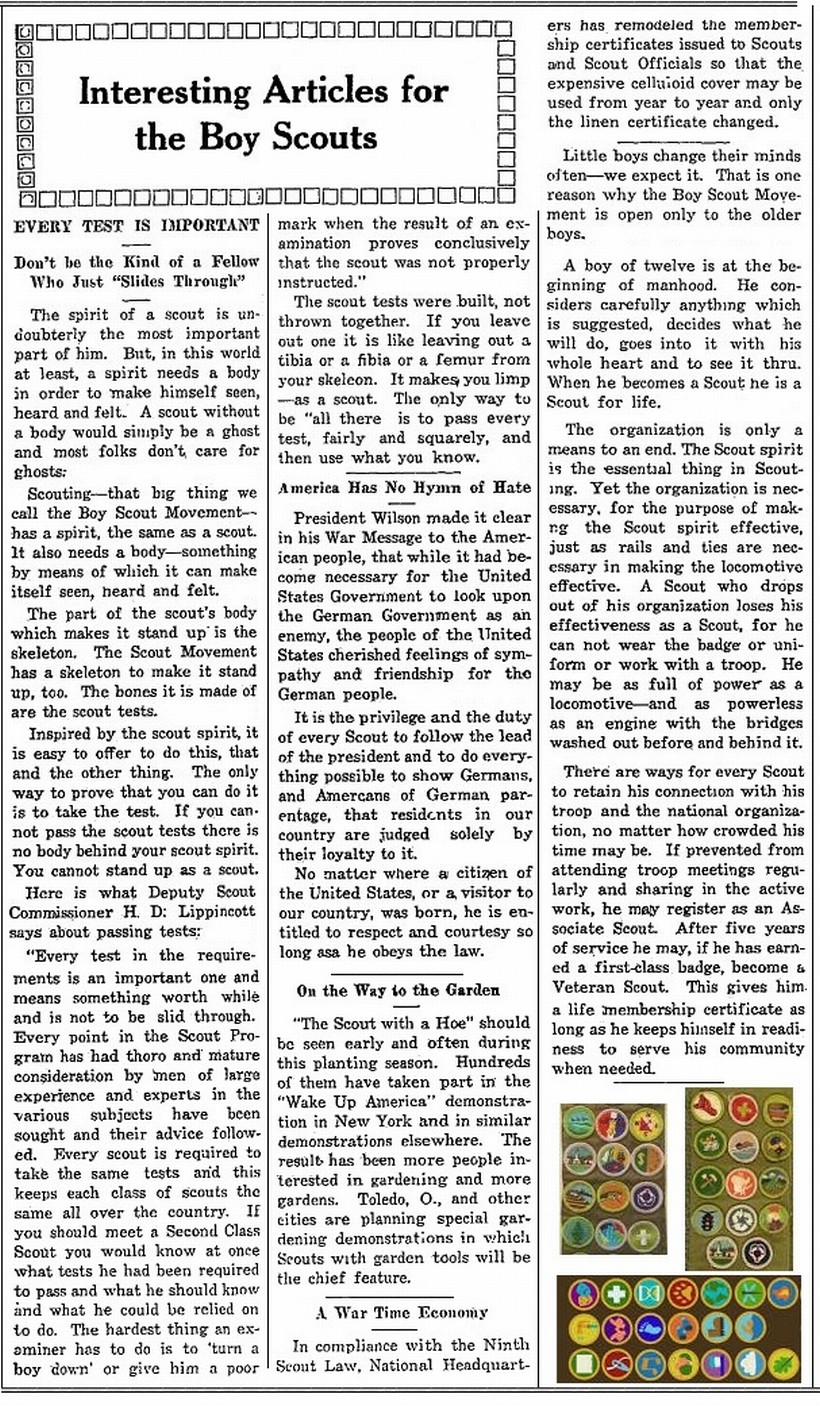
(Click to enlarge this article from June 7, 1917.)
|
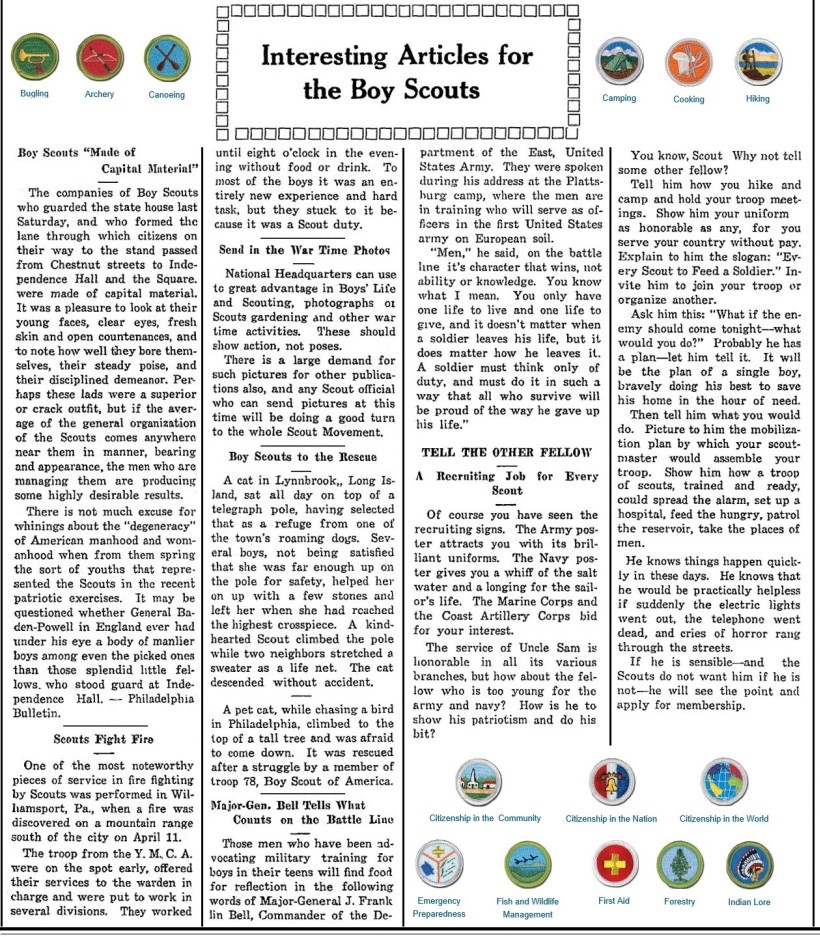
(Click to enlarge)
|
Scouting in 1998
Article published February 5, 1998 in the South
Hamilton Record News.
(You may click the top half or the bottom half of this article to enlarge
and read.)
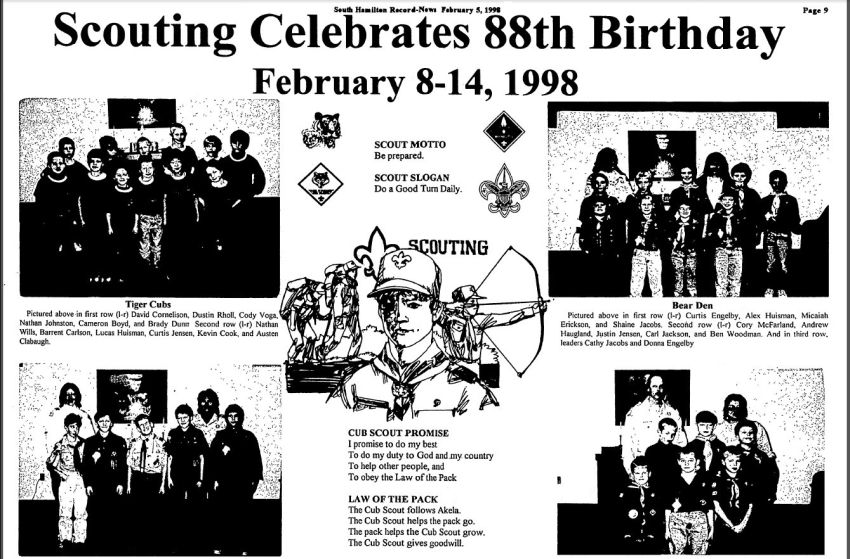
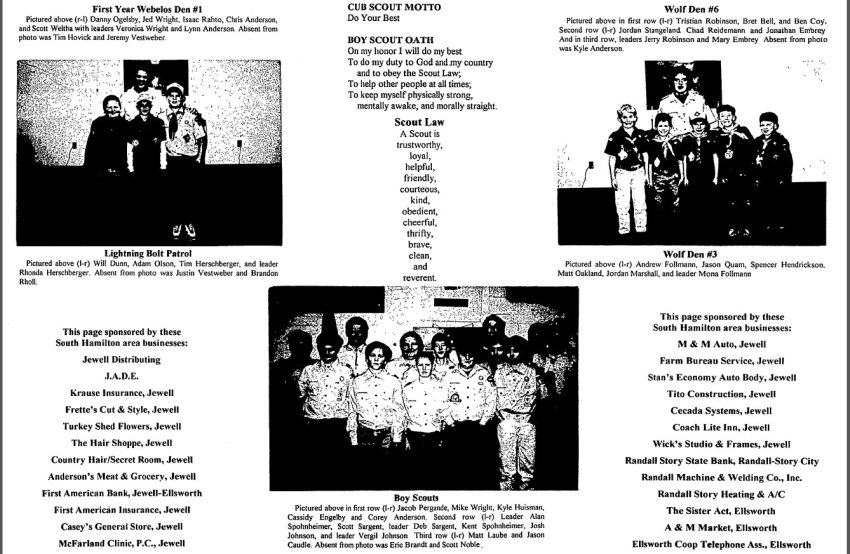
South Hamilton Troop 520 included Scouts from
the area including Ellsworth,
Jewell, Stahope and Randall.
|
Tiger Cubs
Pictured in the first row: David Cornelison, Duston Rholl, Cody Voga,
Nathan Johnston, Cameron Boyd, and Brady Dunn.
Second row: Nathan Wills, Barrent Carlson, Lucas Huisman, Curtis
Jensen, Kevin Cook, and Austen Clabaugh.
First Year Webelos Den #1
Danny Ogelsby, Jed Wright, Isaac Rahto, Chris Anderson and Scott Weltha
with leaders Veronica Wright and Lynn Anderson.
Absent from photo were Tim Hovick and Jeremy Vestweber.
Lightning Bolt Patrol
Will Dunn, Adam Olson, Tim Herschberger, and leader Rhonda Herschberger.
Absent from photo were Justin Vestweber and Brandon Rholl. |
Bear Den
Pictured in the first row: Curtis, Engelby, Alex Hoisman, Micaiah
Erickson, and Shaine Jacobs.
Second row: Cory McFarland, Andrew Haugland, Justin Jensen, Carl
Jackson, and Ben Woodman.
And in the third row: leaders Cathy Jacobs and Donna Engelby.
Wolf Den #6
Pictured in the first row: Tristian Robinson, Bret Bell, and Ben Coy.
Second row: Jordan Stangeland, Chad Reidemenn and Jonathan Embrey.
And in the third row: leaders Jerry Robinson and Mary Embrey.
Absent from photo was Kyle Anderson.
Wolf Den #3
Andrew Follmann, Jason Quam, Spencer Hendrickson, Matt Oakland, Jordan
Marshall, and leader Mona Follmann. |
|
Boy Scouts
First Row: Jacob Pergande, Mike Wright, Kyle Huisman,
Cassidy Engelby and Corey Anderson.
Second Row: Leader Alan Spohnheimer, Scott Sargent,
Leader Deb Sargent, Kent Spohnheimer, Josh Johnson, and leader
Vergil Johnson.
Third Row: Matt Laube and Jason Caudle. Absent from photo
were Eric Brandt and Scott Noble. |
|

(Back to Contents)
back Home
|

